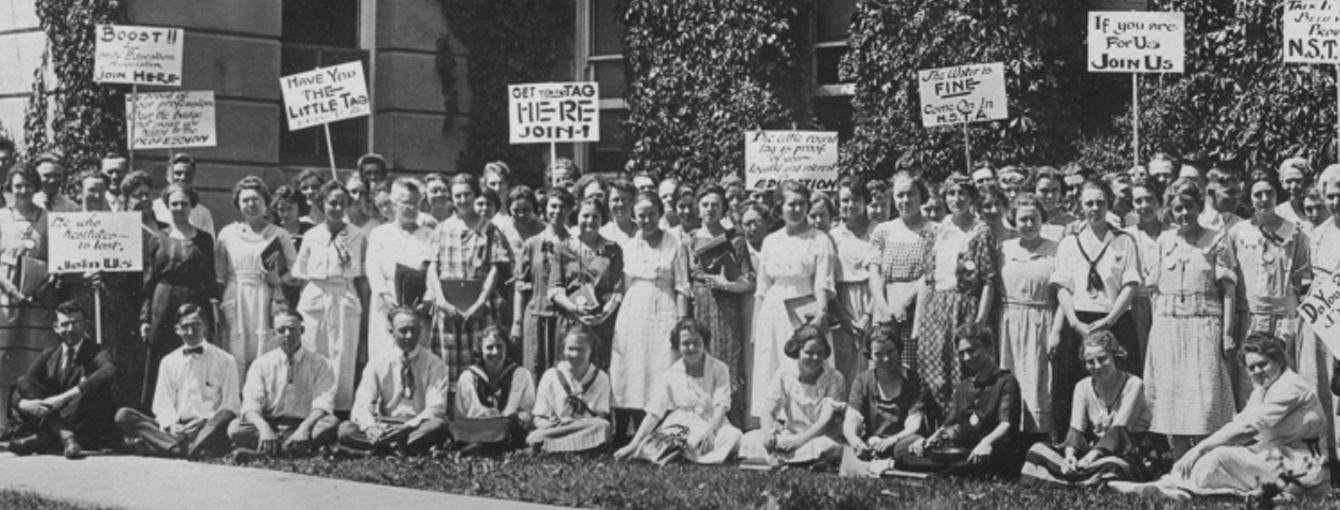Teacher Retirement History
Membership Makes Dollars and Sense
For many years, NSEA has been working to improve teacher retirement benefits and will continue to do so. The proud history of NSEA's Retirement Committee and lobbying efforts include the following retirement benefit enhancements:
-
- 1909 Establishment of Omaha Public Schools teachers retirement plan
- 1945 Creation of the Nebraska School Employees Retirement plan for all public school teachers except those in the Omaha plan
- 1955 School Employees in Nebraska voted to join Social Security
- 1968 Formula established. Employees contributed 3.5% of salary. School Districts contributed only 20 percent of employees' contribution
- 1972 NSEA successfully led effort to amend the Nebraska Constitution to permit cost of living increases for retirees; The amendment passed by approximately 100,000 votes
- 1973 The first NSEA Retirement Committee appointed by President Phil Kaldahl. Herb Schimek served as staff liaison
- 1975 Formula factor increased from 1.0 to 1.25 based on top five years of salary (changed from top ten years of salary). An increase in the Board's contribution rate paid for the cost.
- 1978 Membership in School Retirement Plan was made mandatory
- 1981 Formula changed using top three years of salary rather than top five years.
- 1982 Formula factor increased from 1.25 to 1.5
- 1984 Formula factor increased from 1.5 to 1.65
- 1985 Part-time employment contributions credited pro rata toward years of service
- 1986 Early retirement -- 3% reduction to age 60 and buy back; legislators' retirement bill; Omaha system cost-of-living adjustment
- 1987 Elimination of mandatory retirement provisions
- 1988 Increased benefits for retired teachers with 25 yrs of service; credit given for those who taught prior to 21 years of age
- 1989 Increase in benefits for Omaha system
- 1990 Change death benefits provisions
- 1993 Annuity factor increased from 1.65 to 1.73 1995 Omaha system change from 1.70 to 1.80 and Rule of 85
- 1996 Eliminated HELP Act; transferred to retirement. Annuity factor increased from 1.73 to 1.80
- 1997 Five year purchase available
- 1998 COLA for older retirees; Rule of 85; Omaha system factor went from 1.8 to 1.85
- 1999 Annuity factor increased from 1.80 to 1.90; 2% COLA; 75% purchasing power
- 2000 Change disability provisions
- 2001 Annuity factor increased from 1.90 to 2.0; COLA to 2.5%; death benefit provisions for less than 20 years of service
- 2002 IRS rollovers to NPERS and OPS allowed; defines "temporary employee"
- 2004 Guarantees teacher representation on PERB
- 2005 Rate changed from 7.25% employee and 7.32% employer to: 9/1/05 7.98% employee 8.06% employer; 9/1/06 7.83% employee 7.91% employer; 9/1/07 7.25% employee; 7.32% employer
- 2006 Amortization period changed from 25 to 30 years
- 2007 Allows beneficiaries up to 12 months after date of death to apply by death benefits; one-time 85% purchasing power for older retirees; 9/1/07 rate change to 7.28% employee; 7.35% employer
- 2008 Omaha system service annuity 1996 clarification change
- 2009 Rate increased from 7.28% to 8.28% employee for 5 years; 7.35% to 8.28% employer for 5 years; increased state contribution rate from .7% to 1% for 5 years; lump sum contribution by state of $20,000,000 in FY 2010/11 and $40,000,000 in FY 2011/12; budget exclusion for retirement shortfall
- 2011 Increased school employees’ retirement contribution rates to 8.88 percent for 2011-2012 and to 9.78 percent for 2012-2017. The contribution rates are scheduled to return to 7.28 percent in 2017-2018.
- 2013 State Service Annuity contribution rate increased from 1% to 2% of pay. Employee contribution rates remain at 9.78%. New tier for school employees hired after July 1, 2013: 1) average final salary over the five highest year salaries; 2) COLA cap set at 1 percent.
- 2014 Service credit purchase changes
- 2016 Omaha plan changes: OSERS Board of Trustees; aligns the benefits of OSERS with the State plan benefits; investment authority from OSERS to Nebraska Investment Council.
- 2017 For new school employees hired on or after July 1, 2018 full retirement age will be 60 with 25 years of service. New three-year phase out for voluntary separation agreement amounts outside of the lids specifically for teachers in excess of $35,000. Voluntary Separation Agreements are permitted to continue outside the lids only for teachers and not to exceed $35,000.
- 2018 The Public Employees Retirement Board (PERB) was granted the authority to determine employer and employee eligibility to participate under section 414(d) of the Internal Revenue Code.
- 2019 Designated the spouse of a married plan member as the default primary beneficiary in the school retirement plans. Service credit provisions will be the same for all four tiers.
- 2020 Modified Required Minimum Distribution (RMD) language to confirm to changes in federal law. This bill increased the RMD age from 70-1/2 to 72 for individuals who turned 70-1/2 after December 31, 2019.
- 2021 Defines “intermittent” and “day of service” for purposes of substitute service as eight service days each calendar month – which means 48 days during the 180-day period following date of retirement. Transfer of duties and responsibilities for management of the Omaha School Employees Retirement System (OSERS) retirement plan to the Public Employees Retirement Board (PERB) in 2024. Adds a new seat to the PERB to be filled by a teacher member of OSERS in 2024; requires the newly created OSERS Board of Trustees include an OPS teacher representative.
New Educators
The New Generation of Educators in Nebraska (NewGEN) exists to drive early career educators towards success by fostering membership engagement, advancing teaching excellence through professional development, and creating a network of support through mentorship opportunities and classroom resources.
Join Now
NSEA is here for you. From professional growth opportunities and support, to amplifying your voice in public policy affecting you and your classroom, to providing perks like college debt assistance, NSEA has your future in mind. Learn more and join NSEA now.
The NSEA Children's Fund
NSEA established the Children's Fund in 1994 to fulfill modest and immediate needs of struggling students encountered daily by NSEA members in their workplaces. Find out how you can help a child today.
L.E.A.R.N — Providing valuable learning opportunities for educators: LearnNebraska.org Visit Website








